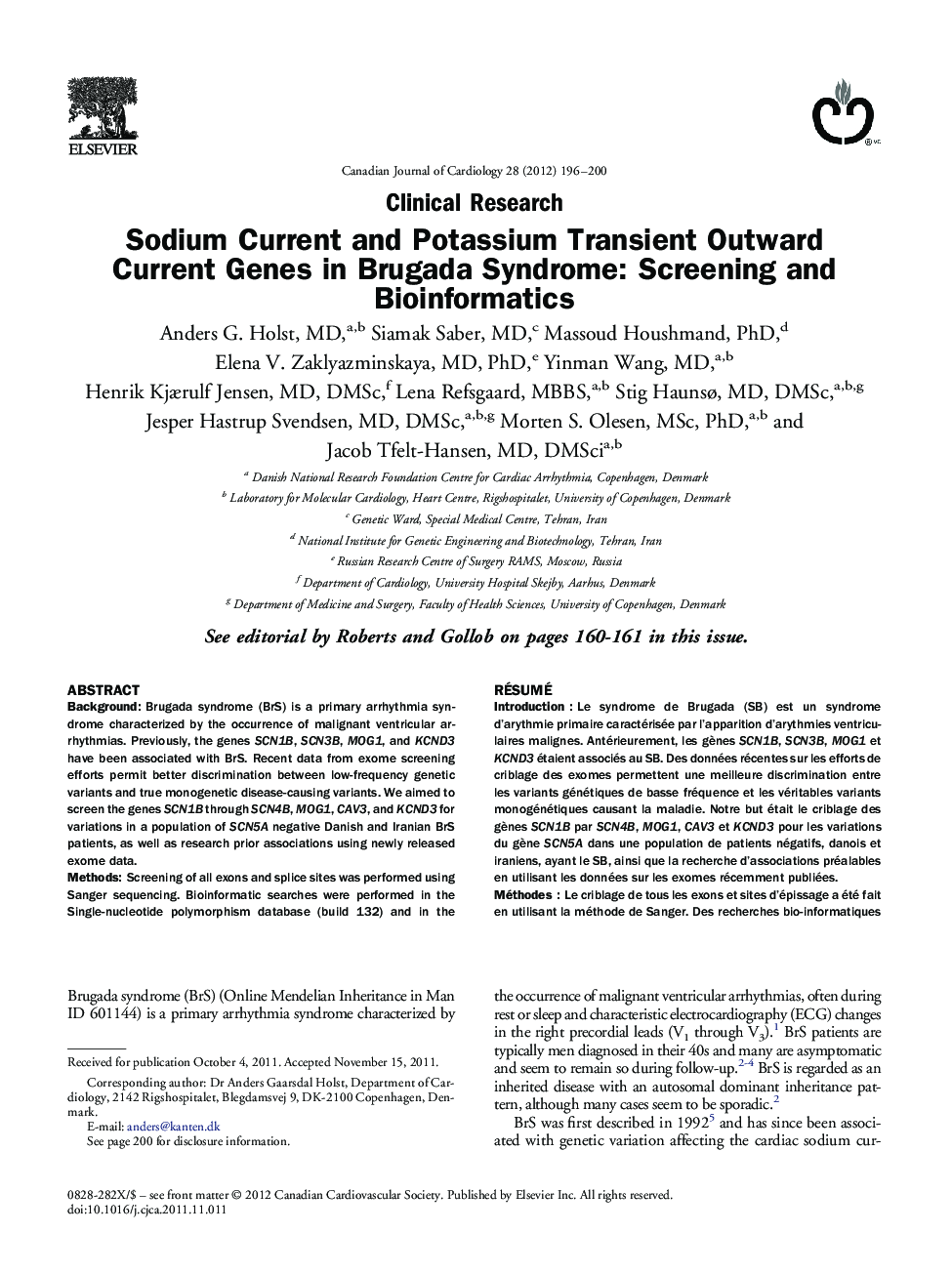| کد مقاله | کد نشریه | سال انتشار | مقاله انگلیسی | نسخه تمام متن |
|---|---|---|---|---|
| 2732087 | 1566537 | 2012 | 5 صفحه PDF | دانلود رایگان |

BackgroundBrugada syndrome (BrS) is a primary arrhythmia syndrome characterized by the occurrence of malignant ventricular arrhythmias. Previously, the genes SCN1B, SCN3B, MOG1, and KCND3 have been associated with BrS. Recent data from exome screening efforts permit better discrimination between low-frequency genetic variants and true monogenetic disease-causing variants. We aimed to screen the genes SCN1B through SCN4B, MOG1, CAV3, and KCND3 for variations in a population of SCN5A negative Danish and Iranian BrS patients, as well as research prior associations using newly released exome data.MethodsScreening of all exons and splice sites was performed using Sanger sequencing. Bioinformatic searches were performed in the Single-nucleotide polymorphism database (build 132) and in the National Heart, Lung, and Blood Institute Grand Opportunity Exome Sequencing Project (ESP) for both previously published variant-BrS associations and newly uncovered variations within the noted genes.ResultsA total of 42 BrS patients were screened, and 2 different nonsynonymous mutations in SCN1Bb (H162P and R214Q) were found in 2 different Danish patients. The variants were not found in 216 Danish controls, but R214Q was present in ESP data (5 of 841 alleles). No other mutations were found. Previously BrS-associated mutations in KNCD3 and SCN3B were also present in ESP data. This was not the case for MOG1, but a nonsense polymorphism was present in 0.5% of alleles.ConclusionsOur study supports the association of SCN1Bb with BrS. However, recently released exome data make some of the prior associations of BrS with genes SCN3B, MOG1, and KCND3 less likely.
RésuméIntroductionLe syndrome de Brugada (SB) est un syndrome d'arythmie primaire caractérisée par l'apparition d'arythmies ventriculaires malignes. Antérieurement, les gènes SCN1B, SCN3B, MOG1 et KCND3 étaient associés au SB. Des données récentes sur les efforts de criblage des exomes permettent une meilleure discrimination entre les variants génétiques de basse fréquence et les véritables variants monogénétiques causant la maladie. Notre but était le criblage des gènes SCN1B par SCN4B, MOG1, CAV3 et KCND3 pour les variations du gène SCN5A dans une population de patients négatifs, danois et iraniens, ayant le SB, ainsi que la recherche d'associations préalables en utilisant les données sur les exomes récemment publiées.MéthodesLe criblage de tous les exons et sites d'épissage a été fait en utilisant la méthode de Sanger. Des recherches bio-informatiques ont été faites dans les bases de données SNP (Single Nucleotide Polymorphism; polymorphisme de nucléotide simple, Build 132) et au National Heart, Lung et Blood Institute Grand Opportunity Exome Sequencing Project (ESP) sur les associations de variants du SB publiées antérieurement et les variations récemment découvertes sur les gènes observés.RésultatsUn total de 42 patients ayant le SB ont été soumis au dépistage, et 2 mutations non synonymes différentes du SCN1Bb (H162P et R214Q) ont été trouvées chez 2 patients danois. Les variants n'ont pas été trouvés parmi les 216 patients témoins, mais le R214Q a été observé dans les données ESP (5 de 841 allèles). Aucune autre mutation n'a été trouvée. Les mutations préalablement associées au SB du KNCD3 et du SCN3B ont aussi été observées dans les données ESP. Cela n'a pas été le cas pour le MOG1, mais un polymorphisme non-sens a été observé dans 0,5 % des allèles.ConclusionsNotre étude soutient que le SCN1Bb est associé au SB. Cependant, les données sur les exomes récemment publiées sur les associations préalables du SB avec les gènes SCN3B, MOG1 et KCND3 sont moins probables.
Journal: Canadian Journal of Cardiology - Volume 28, Issue 2, March–April 2012, Pages 196–200